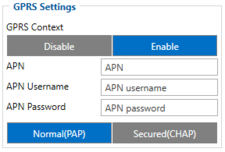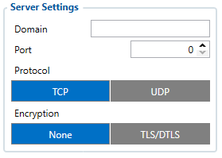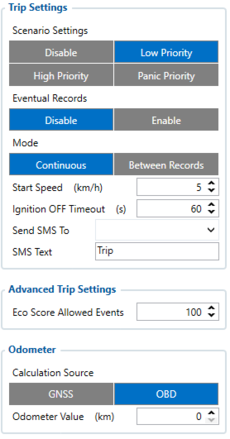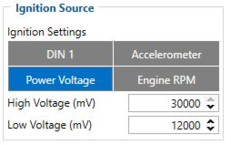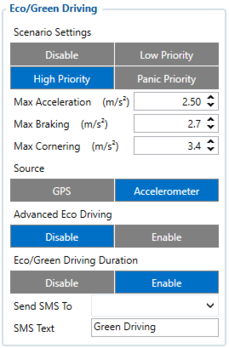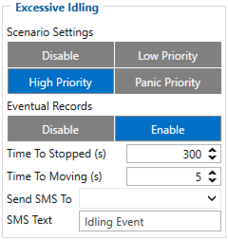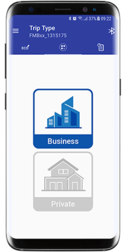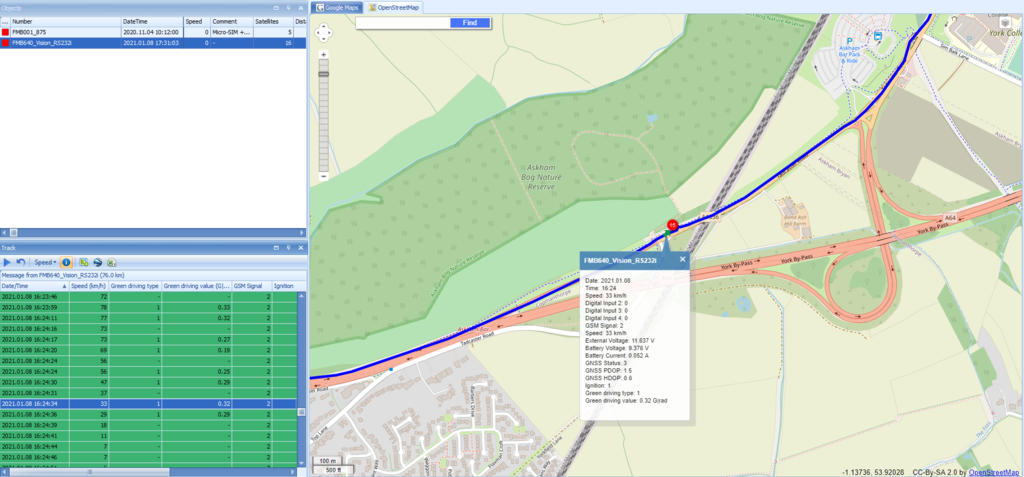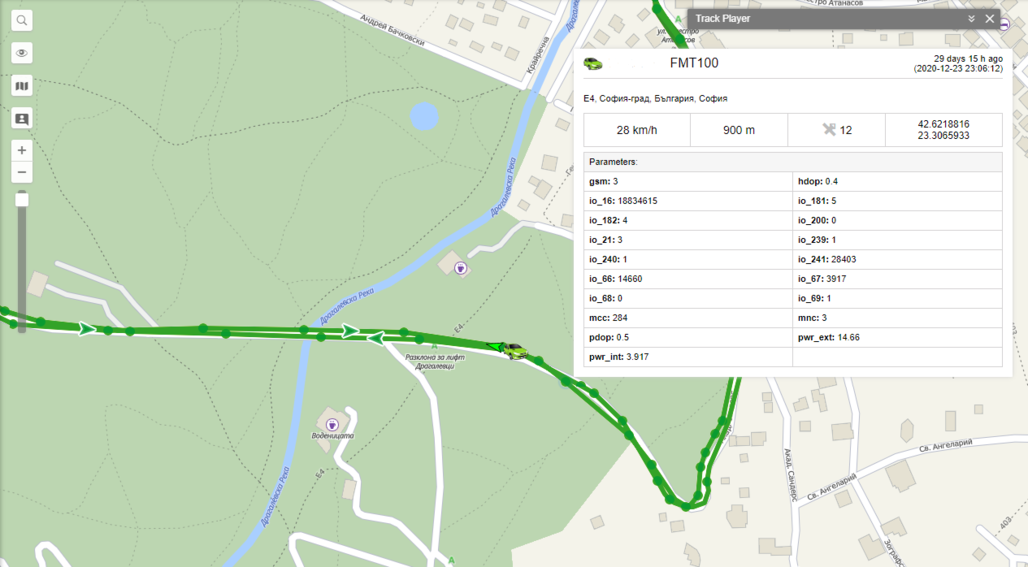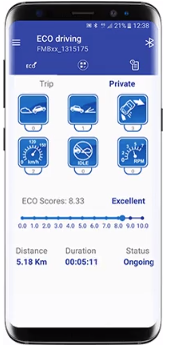Difference between revisions of "GPS Electronic Logbook"
m (Text replacement - "Bluetooth(?!®)" to "Bluetooth®") |
|||
| (78 intermediate revisions by 6 users not shown) | |||
| Line 1: | Line 1: | ||
| − | == | + | ==Solution description== |
| − | + | If you are one of those drivers or fleet managers who find doing your logbook a tedious and time-consuming process, we have got good news for you. Thanks to Teltonika GPS trackers, you can automate nearly the whole process by using an accurate and reliable GPS electronic logbook. | |
| − | + | Here You will find how to prepare and test this solution. | |
| − | + | ==What you need for the solution?== | |
| − | + | * | |
| + | *Teltonika FM device which is compatible with this use case. Recommended products are: [[FMB001]], [[FMC001]], [[FMM001]], [[FM3001]], [[FMB002]], [[FMB010]], [[FMB003]], [[FMB020]], [[FMP100]] ( FMP100 is connected via cigarette light socket). | ||
| + | *The SIM card in order to receive data to Your server. | ||
| + | *[[Teltonika Configurator]] to set up FM device correctly for the solution. | ||
| + | *[[FOTA WEB]] to remotely send the configuration to the device. | ||
| + | *[[BTAPP Mobile application|BTAPP]] / Driver application for Private Mode or Business Mode selection. | ||
| − | == | + | ==Installation== |
| + | All of the recommended products are "Plug and Play" devices. It means that devices are directly plugged into vehicles OBDII socket and after configuration is complete - devices are set for use. Although, if plugged OBDII device is too hard to reach and vehicle parts are interfering with GPS signal or vehicle parts need to be removed/opened to access OBDII socket and afterward parts no longer fit or close - Teltonika offers OBDII extension cable. [https://teltonika-gps.com/product/obdii-cable/] | ||
| − | + | Apart from device configuration (more later) and installation into the vehicle, the GPS electronic logbook doesn't require additional hands-on work. | |
| − | |||
| − | |||
| − | |||
| − | |||
| − | |||
| − | == | + | ==Configuration== |
| − | |||
| − | + | === '''1. Prerequisites:'''=== | |
| − | + | ====1.1. Read through [https://wiki.teltonika-gps.com/view/FMB001_First_Start First start guide]==== | |
| − | == Configuration == | + | === '''2. Configuration of GPS electronic logbook scenario:'''=== |
| + | [[File:Gprs settings.png|left|thumb|225x225px]]''Parameter ID'' - ''Parameter name'' | ||
| + | |||
| + | *<span style="background-color:#71c5f9;">2001</span> – APN | ||
| + | *<span style="background-color:#50b6b1;">2002</span> – APN username (if there are no APN username, empty field should be left) | ||
| + | *<span style="background-color:#c123d9;">2003</span> – APN password (if there are no APN password, empty field should be left) | ||
| + | |||
| + | |||
| + | [[File:Server settings.png|left|thumb|222x222px]] | ||
| + | <br> | ||
| + | <br> | ||
| + | <br> | ||
| + | Server settings: | ||
| + | *<span style="background-color:#b1c623;">2004</span> – Domain | ||
| + | *<span style="background-color:#f450e2;">2005</span> – Port | ||
| + | *<span style="background-color:#d4b011;">2006</span> – Data sending protocol (0 – TCP, 1 – UDP | ||
| + | <br> | ||
| + | <br> | ||
| + | After successful GPRS/SERVER settings configuration, device will '''synchronize time''' and '''update records''' to '''the configured server'''. Time intervals and default I/O elements can be changed by using [[Teltonika Configurator]] or [[FMB920 Parameter list|SMS parameters]]. | ||
| − | |||
| − | |||
| − | |||
| − | |||
[[File:Trip settings.png|left|thumb|439x439px]] | [[File:Trip settings.png|left|thumb|439x439px]] | ||
| − | + | <br> | |
| + | Configuration of Trip scenario: | ||
| − | |||
*<span style="background-color:#91b9d4;">11800</span> - Scenario priority (0 - Disable, 1 - Low, 2 - High, 3 - Panic). | *<span style="background-color:#91b9d4;">11800</span> - Scenario priority (0 - Disable, 1 - Low, 2 - High, 3 - Panic). | ||
<br> | <br> | ||
*<span style="background-color:#91d4b9;">11801</span> - Eventual settings (0 - Disable, 1 - Enable), if disabled - trip settings will come with periodical data. | *<span style="background-color:#91d4b9;">11801</span> - Eventual settings (0 - Disable, 1 - Enable), if disabled - trip settings will come with periodical data. | ||
| − | + | ||
| − | * 11802 - Mode (0 - Continuous, 1 Between Records). If Between Records option is selected distance will be counted until any record is made. Then odometer will be reset to zero and start counting until next record is made. | + | *11802 - Mode (0 - Continuous, 1 Between Records). If the ''Between Records'' option is selected - distance will be counted until any record is made. Then odometer will be reset to zero and start counting until the next record is made. If the ''Continues'' option is selected - the distance will continue counting between the trip start and trip stop and the odometer will not reset. |
| − | * 11803 - Start Speed (km/h). | + | *11803 - Start Speed (km/h). When selecting a value for Start Speed - only after this value (speed) is exceeded, the Trip scenario will be activated. If the Start Speed value is set to 0 (km/h) - the scenario will be activated after the ignition turns on. ''More about ignition settings - below.'' |
| − | * 11804 - Ignition OFF timeout (s). | + | *11804 - Ignition OFF timeout (s). |
* 7031 - ID of SMS recipient. | * 7031 - ID of SMS recipient. | ||
| − | * 8031 - SMS Text. | + | *8031 - SMS Text. |
| − | * 700 - Eco Score Allowed Events. | + | *700 - Eco Score Allowed Events. |
<br> | <br> | ||
*<span style="background-color:#b991d4;">11806</span> - Odometer Calculation Source (0 - GNSS, 1 - OBD). | *<span style="background-color:#b991d4;">11806</span> - Odometer Calculation Source (0 - GNSS, 1 - OBD). | ||
* 11807 - current Odometer Value (km). Odometer data will be counted from provided value. | * 11807 - current Odometer Value (km). Odometer data will be counted from provided value. | ||
| + | [[File:Screenshot 2021-03-07 162223.png|left|thumb|231x231px]] | ||
| + | |||
| + | |||
| + | |||
| + | |||
| + | Configuration of Ignition Source: | ||
| + | |||
| + | * 101 - Ignition Settings ( Ignition has 14 different settings, for more information click [[FMB001 Parameter list|'''here''']]). | ||
| + | |||
| + | '''Note''': if Ignition Source is selected only to Accelerometer - ignition will be activated when the vehicle starts moving. Engine RPM - cannot be used for every vehicle model. Direct OBDII devices gather information received via the OBDII socket. If the vehicle doesn't provide Engine RPM via mentioned socket - Engine RPM cannot be used as Ignition Source. | ||
| + | |||
| + | * 104 - High Voltage ( value range: 13200 - 30000 mV). | ||
| + | * 105 - Low Voltage ( value range: 0 - 29999 mV). | ||
[[File:Green - Eco driving.png|left|thumb|348x348px]] | [[File:Green - Eco driving.png|left|thumb|348x348px]] | ||
| − | + | ||
| − | + | ||
| − | <br> | + | <br>Configuration of Eco/Green driving scenario: |
| − | |||
| − | |||
*<span style="background-color:#b9d491;">11000</span> - Scenario priority (0 - Disable, 1 - Low, 2 - High, 3 - Panic). | *<span style="background-color:#b9d491;">11000</span> - Scenario priority (0 - Disable, 1 - Low, 2 - High, 3 - Panic). | ||
| − | + | ||
| − | * 11004 - Maximum Acceleration (m/s<sup>2</sup>). | + | *11004 - Maximum Acceleration (m/s<sup>2</sup>). |
| − | * 11005 - Maximum Braking (m/s<sup>2</sup>) | + | *11005 - Maximum Braking (m/s<sup>2</sup>) |
| − | * 11006 - Maximum Cornering (m/s<sup>2</sup>) | + | *11006 - Maximum Cornering (m/s<sup>2</sup>) |
*<span style="background-color:#d491b9;">11007</span> - Source (0 - GPS, 1 - Accelerometer). Green driving scenario according to selected data source. | *<span style="background-color:#d491b9;">11007</span> - Source (0 - GPS, 1 - Accelerometer). Green driving scenario according to selected data source. | ||
<br> | <br> | ||
| − | * 11019 - Advanced Eco Driving (0 - Disable, 1 - Enable). If enabled, Eco Driving Average (ID.: 11011) and / or Eco Driving Maximum (ID.: 11015) settings can be changed. | + | |
| + | *11019 - Advanced Eco Driving (0 - Disable, 1 - Enable). If enabled, Eco Driving Average (ID.: 11011) and/or Eco Driving Maximum (ID.: 11015) settings can be changed. | ||
* 11008 - Eco/Green Driving Duration (0 - Disable, 1 - Enable). | * 11008 - Eco/Green Driving Duration (0 - Disable, 1 - Enable). | ||
| − | * 7034 - ID of SMS recipient. | + | *7034 - ID of SMS recipient. |
| − | * 8034 - SMS Text.<br /> '''Note''': Maximum acceleration, braking and cornering values should be set according to vehicle type, power, weight and etc. Best values can be approached by practical testing. | + | *8034 - SMS Text. |
| − | + | <br /> | |
| + | <br /> | ||
| + | <br /> '''Note''': Maximum acceleration, braking, and cornering values should be set according to vehicle type, power, weight and etc. Best values can be approached by practical testing. E.g. testing cornering parameters - take the same turn at a different speed (30km/h, 20 km/h, 40 km/h) and check if Eco/Green Driving event has been triggered for cornering - if it feels as turning on 30km/h is harsh but the event is not triggered - lower Max Cornering values and reattempt the test.<br> | ||
| + | <br> | ||
[[File:Idlingg.png|left|thumb|240x240px]] | [[File:Idlingg.png|left|thumb|240x240px]] | ||
| − | + | Configuration of Excessive idling scenario: | |
| − | |||
*<span style="background-color:#d4b991;">11200</span> - Scenario priority (0 - Disable, 1 - Low, 2 - High, 3 - Panic). | *<span style="background-color:#d4b991;">11200</span> - Scenario priority (0 - Disable, 1 - Low, 2 - High, 3 - Panic). | ||
<br> | <br> | ||
| − | * 11203 - Eventual settings (0 - Disable, 1 - Enable), if disabled - excessive idling data will come with periodical data | + | *11203 - Eventual settings (0 - Disable, 1 - Enable), if disabled - excessive idling data will come with periodical data. |
| − | |||
| − | |||
| − | |||
| − | |||
| − | |||
| + | *11205 - Time To Stopped (s). Represents how long vehicle should not move with engine ON. | ||
| + | *11206 - To To Moving (s). Represents how long vehicle should be moving with engine ON, to exit idle state. | ||
| + | *7033 - ID of SMS recipient. | ||
| + | *8033 - SMS Text. | ||
| + | <br> | ||
| + | <br> | ||
| + | <br> | ||
| + | <br> | ||
<br> | <br> | ||
| − | '''Quick start:''' From default configuration to GPS electronic logbook records in one SMS: | + | '''Quick start:''' From default configuration to [[FMB001_SMS/GPRS_Commands|GPS electronic logbook records in one SMS]]: |
| − | " setparam <span style="background-color:#91b9d4;">11800</span>:1;<span style="background-color:#91d4b9;">11801</span>:0;<span style="background-color:#b991d4;">11806</span>:1;<span style="background-color:#b9d491;">11000</span>:2;<span style="background-color:#d491b9;">11007</span>:1;<span style="background-color:#d4b991;">11200</span>:2" | + | " setparam <span style="background-color:#71c5f9;">2001</span>:APN;<span style="background-color:#50b6b1;">2002</span>:APN_username;<span style="background-color:#c123d9;">2003</span>:APN_password;<span style="background-color:#b1c623;">2004</span>:Domain;<span style="background-color:#f450e2;">2005</span>:Port;<span style="background-color:#d4b011;">2006</span>:0;<span style="background-color:#91b9d4;">11800</span>:1;<span style="background-color:#91d4b9;">11801</span>:0;<span style="background-color:#b991d4;">11806</span>:1;<span style="background-color:#b9d491;">11000</span>:2;<span style="background-color:#d491b9;">11007</span>:1;<span style="background-color:#d4b991;">11200</span>:2" |
| − | This SMS will set up Your device to send Trip, Eco/Green driving and Excessive idling data to Your previously provided server. | + | This SMS will set up Your device to send Trip, Eco/Green driving, and Excessive idling data to Your previously provided server. |
| − | '''Note''': Before SMS text, two space symbols should be inserted if no SMS username or password was set in SMS / Call settings. | + | '''Note''': Before SMS text, two space symbols should be inserted if no SMS username or password was set in [[FMB001_SMS/Call_settings|SMS / Call settings]]. |
| − | === BTAPP Mobile application === | + | ===3. BTAPP Mobile application=== |
[[File:Business private.png|left|thumb|253x253px]] | [[File:Business private.png|left|thumb|253x253px]] | ||
| − | After making configuration for Your device, it is time to [[BTAPP Mobile application|'''download BTAPP''']]. Keep in mind, app and device connection is established via Blue-tooth. Devices by default come with | + | After making configuration for Your device, it is time to [[BTAPP Mobile application|'''download BTAPP''']]. Keep in mind, app and device connection is established via Blue-tooth. Devices by default come with Bluetooth® enabled and visible. After pairing to the device - You can change the trip type of Your trips by performing a long press on the icon and confirming the change. |
<br> | <br> | ||
<br> | <br> | ||
| Line 106: | Line 137: | ||
<br> | <br> | ||
<br> | <br> | ||
| − | |||
| − | === | + | ==Parsing information== |
| − | + | ||
| + | ==='''1. Prerequisites:'''=== | ||
| − | + | ==== 1.1. Open [[Opening TCP/UDP port|TCP/UDP port]] ==== | |
| − | === Parsing example === | + | ==== 1.2. Go to [[Java Parser First Start Guide|Java parser first start guide]] ==== |
| + | |||
| + | ==='''2.Parsing example:'''=== | ||
{| class="nd-othertables_2" style="width:100%;" | {| class="nd-othertables_2" style="width:100%;" | ||
! rowspan="1" style="width:100%; vertical-align: middle; text-align: center;" |Unparsed received data in hexadecimal stream | ! rowspan="1" style="width:100%; vertical-align: middle; text-align: center;" |Unparsed received data in hexadecimal stream | ||
| Line 127: | Line 160: | ||
! rowspan="1" style="width:50%; vertical-align: middle; text-align: center;" |HEX Code Part | ! rowspan="1" style="width:50%; vertical-align: middle; text-align: center;" |HEX Code Part | ||
|- | |- | ||
| − | | style="vertical-align: middle; text-align: center;" |Zero Bytes | + | | style="vertical-align: middle; text-align: center;" | Zero Bytes |
| style="vertical-align: middle; text-align: center;" |00 00 00 00 | | style="vertical-align: middle; text-align: center;" |00 00 00 00 | ||
|- | |- | ||
| Line 142: | Line 175: | ||
| style="vertical-align: middle; text-align: center;" |00 00 01 77 16 AE 03 D8 (Mon Jan 18 18:07:19 UTC 2021) | | style="vertical-align: middle; text-align: center;" |00 00 01 77 16 AE 03 D8 (Mon Jan 18 18:07:19 UTC 2021) | ||
|- | |- | ||
| − | | style="vertical-align: middle; text-align: center;" |Priority | + | | style="vertical-align: middle; text-align: center;" | Priority |
| style="vertical-align: middle; text-align: center;" |01 | | style="vertical-align: middle; text-align: center;" |01 | ||
|- | |- | ||
| Line 184: | Line 217: | ||
| style="vertical-align: middle; text-align: center;" |01 | | style="vertical-align: middle; text-align: center;" |01 | ||
|- | |- | ||
| − | | style="vertical-align: middle; text-align: center;" |3’rd IO ID | + | | style="vertical-align: middle; text-align: center;" | 3’rd IO ID |
| style="vertical-align: middle; text-align: center;" |15 (AVL ID: 21, Name: GSM Signal) | | style="vertical-align: middle; text-align: center;" |15 (AVL ID: 21, Name: GSM Signal) | ||
|- | |- | ||
| − | | style="vertical-align: middle; text-align: center;" |3’rd IO Value | + | | style="vertical-align: middle; text-align: center;" | 3’rd IO Value |
| style="vertical-align: middle; text-align: center;" |05 | | style="vertical-align: middle; text-align: center;" |05 | ||
|- | |- | ||
| − | |style="vertical-align: middle; text-align: center;" |4'th IO ID | + | | style="vertical-align: middle; text-align: center;" |4'th IO ID |
| − | |style="vertical-align: middle; text-align: center;" |50 (AVL ID: 80, Name: Data mode) | + | | style="vertical-align: middle; text-align: center;" |50 (AVL ID: 80, Name: Data mode) |
|- | |- | ||
| − | |style="vertical-align: middle; text-align: center;" |4'th IO Value | + | | style="vertical-align: middle; text-align: center;" |4'th IO Value |
| − | |style="vertical-align: middle; text-align: center;" |01 | + | | style="vertical-align: middle; text-align: center;" |01 |
|- | |- | ||
| style="vertical-align: middle; text-align: center;" |5'th IO ID | | style="vertical-align: middle; text-align: center;" |5'th IO ID | ||
| Line 200: | Line 233: | ||
|- | |- | ||
| style="vertical-align: middle; text-align: center;" |5'th IO Value | | style="vertical-align: middle; text-align: center;" |5'th IO Value | ||
| − | | style="vertical-align: middle; text-align: center;" |00 | + | | style="vertical-align: middle; text-align: center;" | 00 |
|- | |- | ||
| style="vertical-align: middle; text-align: center;" |6'th IO ID | | style="vertical-align: middle; text-align: center;" |6'th IO ID | ||
| Line 206: | Line 239: | ||
|- | |- | ||
| style="vertical-align: middle; text-align: center;" |6'th IO Value | | style="vertical-align: middle; text-align: center;" |6'th IO Value | ||
| − | | style="vertical-align: middle; text-align: center;" |01 | + | | style="vertical-align: middle; text-align: center;" | 01 |
|- | |- | ||
| − | |style="vertical-align: middle; text-align: center;" |7'th IO ID | + | | style="vertical-align: middle; text-align: center;" |7'th IO ID |
| − | |style="vertical-align: middle; text-align: center;" |01 (AVL ID: 1, Name: Digital Input 1) | + | | style="vertical-align: middle; text-align: center;" |01 (AVL ID: 1, Name: Digital Input 1) |
|- | |- | ||
| − | |style="vertical-align: middle; text-align: center;" |7'th IO Value | + | | style="vertical-align: middle; text-align: center;" |7'th IO Value |
| − | |style="vertical-align: middle; text-align: center;" |01 | + | | style="vertical-align: middle; text-align: center;" |01 |
|- | |- | ||
| style="vertical-align: middle; text-align: center;" |8'th IO ID | | style="vertical-align: middle; text-align: center;" |8'th IO ID | ||
| Line 220: | Line 253: | ||
| style="vertical-align: middle; text-align: center;" |<span style="background:#0b9768">03</span> (01 - harsh acceleration, 02 - harsh braking, 03 - harsh cornering) | | style="vertical-align: middle; text-align: center;" |<span style="background:#0b9768">03</span> (01 - harsh acceleration, 02 - harsh braking, 03 - harsh cornering) | ||
|- | |- | ||
| − | |style="vertical-align: middle; text-align: center;" |9'th IO ID | + | | style="vertical-align: middle; text-align: center;" |9'th IO ID |
| − | |style="vertical-align: middle; text-align: center;" |<span style="background:#0b9768">FE</span> (AVL ID: 254, Name: Green Driving Value) | + | | style="vertical-align: middle; text-align: center;" |<span style="background:#0b9768">FE</span> (AVL ID: 254, Name: Green Driving Value) |
|- | |- | ||
| − | |style="vertical-align: middle; text-align: center;" |9'th IO Value | + | | style="vertical-align: middle; text-align: center;" |9'th IO Value |
| − | |style="vertical-align: middle; text-align: center;" |<span style="background:#0b9768">23</span> ( Depending on green driving type: if harsh acceleration or braking - g*100 (value 123 ->1,23g). If Green driving source is "GPS" - harsh cornering value is rad/s*100. If source is "Accelerometer" - g*100. | + | | style="vertical-align: middle; text-align: center;" |<span style="background:#0b9768">23</span> ( Depending on green driving type: if harsh acceleration or braking - g*100 (value 123 ->1,23g). If Green driving source is "GPS" - harsh cornering value is rad/s*100. If source is "Accelerometer" - g*100. |
|- | |- | ||
| − | | style="vertical-align: middle; text-align: center;" |N2 of Two Byte IO | + | | style="vertical-align: middle; text-align: center;" | N2 of Two Byte IO |
| style="vertical-align: middle; text-align: center;" |0B | | style="vertical-align: middle; text-align: center;" |0B | ||
|- | |- | ||
| Line 259: | Line 292: | ||
| style="vertical-align: middle; text-align: center;" |0F 8A | | style="vertical-align: middle; text-align: center;" |0F 8A | ||
|- | |- | ||
| − | |style="vertical-align: middle; text-align: center;" |6'th IO ID | + | | style="vertical-align: middle; text-align: center;" | 6'th IO ID |
| − | |style="vertical-align: middle; text-align: center;" |44 (AVL ID: 68, Name: Battery Current) | + | | style="vertical-align: middle; text-align: center;" |44 (AVL ID: 68, Name: Battery Current) |
|- | |- | ||
| − | |style="vertical-align: middle; text-align: center;" |6'th IO Value | + | | style="vertical-align: middle; text-align: center;" |6'th IO Value |
| − | |style="vertical-align: middle; text-align: center;" |00 00 | + | | style="vertical-align: middle; text-align: center;" |00 00 |
|- | |- | ||
| style="vertical-align: middle; text-align: center;" |7'th IO ID | | style="vertical-align: middle; text-align: center;" |7'th IO ID | ||
| Line 289: | Line 322: | ||
| style="vertical-align: middle; text-align: center;" |FB D9 | | style="vertical-align: middle; text-align: center;" |FB D9 | ||
|- | |- | ||
| − | |style="vertical-align: middle; text-align: center;" |11'th IO ID | + | | style="vertical-align: middle; text-align: center;" |11'th IO ID |
| − | |style="vertical-align: middle; text-align: center;" |0F (AVL ID: 15, Name: Eco score) | + | | style="vertical-align: middle; text-align: center;" |0F (AVL ID: 15, Name: Eco score) |
|- | |- | ||
| − | |style="vertical-align: middle; text-align: center;" |11'th IO Value | + | | style="vertical-align: middle; text-align: center;" |11'th IO Value |
| − | |style="vertical-align: middle; text-align: center;" |03 84 | + | | style="vertical-align: middle; text-align: center;" |03 84 |
|- | |- | ||
| − | |style="vertical-align: middle; text-align: center;" |N4 of Four Byte IO | + | | style="vertical-align: middle; text-align: center;" |N4 of Four Byte IO |
| − | |style="vertical-align: middle; text-align: center;" |02 | + | | style="vertical-align: middle; text-align: center;" |02 |
|- | |- | ||
| − | |style="vertical-align: middle; text-align: center;" |1'st IO ID | + | | style="vertical-align: middle; text-align: center;" |1'st IO ID |
| − | |style="vertical-align: middle; text-align: center;" |<span style="background:#0b9768">02 C7</span>(AVL ID: 199, Name: Trip Odometer) | + | | style="vertical-align: middle; text-align: center;" |<span style="background:#0b9768">02 C7</span>(AVL ID: 199, Name: Trip Odometer) |
|- | |- | ||
| − | |style="vertical-align: middle; text-align: center;" |1’st IO Value | + | | style="vertical-align: middle; text-align: center;" |1’st IO Value |
| − | |style="vertical-align: middle; text-align: center;" |00 00 03 BD | + | | style="vertical-align: middle; text-align: center;" | 00 00 03 BD |
|- | |- | ||
| − | |style="vertical-align: middle; text-align: center;" |2’nd IO ID | + | | style="vertical-align: middle; text-align: center;" |2’nd IO ID |
| − | |style="vertical-align: middle; text-align: center;" |<span style="background:#0b9768">10 03</span>(AVL ID: 16, Name: Total Odometer) | + | | style="vertical-align: middle; text-align: center;" |<span style="background:#0b9768">10 03</span>(AVL ID: 16, Name: Total Odometer) |
|- | |- | ||
| − | |style="vertical-align: middle; text-align: center;" |2’nd IO Value | + | | style="vertical-align: middle; text-align: center;" |2’nd IO Value |
| − | |style="vertical-align: middle; text-align: center;" |06 68 80 20 | + | | style="vertical-align: middle; text-align: center;" |06 68 80 20 |
|- | |- | ||
| − | |style="vertical-align: middle; text-align: center;" |Number of Data 2 (Number of Total Records) | + | | style="vertical-align: middle; text-align: center;" |Number of Data 2 (Number of Total Records) |
| − | |style="vertical-align: middle; text-align: center;" |01 | + | | style="vertical-align: middle; text-align: center;" |01 |
|- | |- | ||
| − | |style="vertical-align: middle; text-align: center;" |CRC-16 | + | | style="vertical-align: middle; text-align: center;" |CRC-16 |
| − | |style="vertical-align: middle; text-align: center;" |00 00 5F 75 | + | | style="vertical-align: middle; text-align: center;" |00 00 5F 75 |
|} | |} | ||
| − | == | + | ==Demonstration in platform== |
| − | Packet information can be displayed visually. In the picture below, event location is displayed on the map. | + | Packet information can be displayed visually. In the picture below, the event location is displayed on the map. The dot on the map represents a record. By clicking on it, it is possible to see what kind of information is gathered in the particular entry. |
| + | |||
| + | In order to visually see received information on the platforms: | ||
| + | |||
| + | '''[[Teltonika TAVL|TAVL]]''': Open TAVL → select client → select Street Map → select device → to choose the date from which to show the records → push advanced → push show button and then you will see in the left down corner all information. | ||
[[File:Viz.png|center|thumb|1024x1024px]] | [[File:Viz.png|center|thumb|1024x1024px]] | ||
| − | |||
| − | + | ||
| − | + | '''[https://gurtam.com/en/wialon WIALON]''': Open WIALON → open messages → push unit ( select your device) → choose the date from which to show the records → select message (data messages) → push execute button and you will see all information. (Note''':''' ''Figure below is an example and doesn't represent the actual visualization of the packet in the parsing example'').[[File:Wialon snip.png|center|thumb|1028x1028px]] | |
| + | [[Category:Usage scenarios]] | ||
| + | |||
| + | '''BTAPP''': [[File:Eco.PNG|left|thumb|600x600px]] | ||
| + | |||
| + | Bluetooth® connection to monitor and score driver behavior. Real-time events notifications about harsh acceleration, braking, cornering, overspeeding, idling, and RPM. Solution designed to improve driver behavior and productivity. | ||
| + | |||
| + | *You must connect to the FMB device by clicking the Bluetooth® icon, and selecting your FMB device. | ||
| + | *Each event that was detected by the FMB device will be displayed in the application as well. Users can be notified visually, the event icon will turn yellow and the event count will be increased accordingly, and by sound alert as well (can be optionally enabled in application settings). | ||
| + | *Eco score is calculated by FMB device depending on total event amount and trip distance. | ||
| + | Eco score, distance, and duration are being updated periodically automatically. | ||
| + | *Trip status can be Ongoing and Finished. The trip finish is decided by FMB configuration. If the application will be connected to an FMB device during an ongoing trip – the application will update event count, score, distance, and trip duration for an ongoing trip. | ||
Latest revision as of 15:22, 28 December 2023
Main Page > General Information > Usage scenarios > GPS Electronic LogbookSolution description
If you are one of those drivers or fleet managers who find doing your logbook a tedious and time-consuming process, we have got good news for you. Thanks to Teltonika GPS trackers, you can automate nearly the whole process by using an accurate and reliable GPS electronic logbook.
Here You will find how to prepare and test this solution.
What you need for the solution?
- Teltonika FM device which is compatible with this use case. Recommended products are: FMB001, FMC001, FMM001, FM3001, FMB002, FMB010, FMB003, FMB020, FMP100 ( FMP100 is connected via cigarette light socket).
- The SIM card in order to receive data to Your server.
- Teltonika Configurator to set up FM device correctly for the solution.
- FOTA WEB to remotely send the configuration to the device.
- BTAPP / Driver application for Private Mode or Business Mode selection.
Installation
All of the recommended products are "Plug and Play" devices. It means that devices are directly plugged into vehicles OBDII socket and after configuration is complete - devices are set for use. Although, if plugged OBDII device is too hard to reach and vehicle parts are interfering with GPS signal or vehicle parts need to be removed/opened to access OBDII socket and afterward parts no longer fit or close - Teltonika offers OBDII extension cable. [1]
Apart from device configuration (more later) and installation into the vehicle, the GPS electronic logbook doesn't require additional hands-on work.
Configuration
1. Prerequisites:
1.1. Read through First start guide
2. Configuration of GPS electronic logbook scenario:
Parameter ID - Parameter name
- 2001 – APN
- 2002 – APN username (if there are no APN username, empty field should be left)
- 2003 – APN password (if there are no APN password, empty field should be left)
Server settings:
- 2004 – Domain
- 2005 – Port
- 2006 – Data sending protocol (0 – TCP, 1 – UDP
After successful GPRS/SERVER settings configuration, device will synchronize time and update records to the configured server. Time intervals and default I/O elements can be changed by using Teltonika Configurator or SMS parameters.
Configuration of Trip scenario:
- 11800 - Scenario priority (0 - Disable, 1 - Low, 2 - High, 3 - Panic).
- 11801 - Eventual settings (0 - Disable, 1 - Enable), if disabled - trip settings will come with periodical data.
- 11802 - Mode (0 - Continuous, 1 Between Records). If the Between Records option is selected - distance will be counted until any record is made. Then odometer will be reset to zero and start counting until the next record is made. If the Continues option is selected - the distance will continue counting between the trip start and trip stop and the odometer will not reset.
- 11803 - Start Speed (km/h). When selecting a value for Start Speed - only after this value (speed) is exceeded, the Trip scenario will be activated. If the Start Speed value is set to 0 (km/h) - the scenario will be activated after the ignition turns on. More about ignition settings - below.
- 11804 - Ignition OFF timeout (s).
- 7031 - ID of SMS recipient.
- 8031 - SMS Text.
- 700 - Eco Score Allowed Events.
- 11806 - Odometer Calculation Source (0 - GNSS, 1 - OBD).
- 11807 - current Odometer Value (km). Odometer data will be counted from provided value.
Configuration of Ignition Source:
- 101 - Ignition Settings ( Ignition has 14 different settings, for more information click here).
Note: if Ignition Source is selected only to Accelerometer - ignition will be activated when the vehicle starts moving. Engine RPM - cannot be used for every vehicle model. Direct OBDII devices gather information received via the OBDII socket. If the vehicle doesn't provide Engine RPM via mentioned socket - Engine RPM cannot be used as Ignition Source.
- 104 - High Voltage ( value range: 13200 - 30000 mV).
- 105 - Low Voltage ( value range: 0 - 29999 mV).
Configuration of Eco/Green driving scenario:
- 11000 - Scenario priority (0 - Disable, 1 - Low, 2 - High, 3 - Panic).
- 11004 - Maximum Acceleration (m/s2).
- 11005 - Maximum Braking (m/s2)
- 11006 - Maximum Cornering (m/s2)
- 11007 - Source (0 - GPS, 1 - Accelerometer). Green driving scenario according to selected data source.
- 11019 - Advanced Eco Driving (0 - Disable, 1 - Enable). If enabled, Eco Driving Average (ID.: 11011) and/or Eco Driving Maximum (ID.: 11015) settings can be changed.
- 11008 - Eco/Green Driving Duration (0 - Disable, 1 - Enable).
- 7034 - ID of SMS recipient.
- 8034 - SMS Text.
Note: Maximum acceleration, braking, and cornering values should be set according to vehicle type, power, weight and etc. Best values can be approached by practical testing. E.g. testing cornering parameters - take the same turn at a different speed (30km/h, 20 km/h, 40 km/h) and check if Eco/Green Driving event has been triggered for cornering - if it feels as turning on 30km/h is harsh but the event is not triggered - lower Max Cornering values and reattempt the test.
Configuration of Excessive idling scenario:
- 11200 - Scenario priority (0 - Disable, 1 - Low, 2 - High, 3 - Panic).
- 11203 - Eventual settings (0 - Disable, 1 - Enable), if disabled - excessive idling data will come with periodical data.
- 11205 - Time To Stopped (s). Represents how long vehicle should not move with engine ON.
- 11206 - To To Moving (s). Represents how long vehicle should be moving with engine ON, to exit idle state.
- 7033 - ID of SMS recipient.
- 8033 - SMS Text.
Quick start: From default configuration to GPS electronic logbook records in one SMS:
" setparam 2001:APN;2002:APN_username;2003:APN_password;2004:Domain;2005:Port;2006:0;11800:1;11801:0;11806:1;11000:2;11007:1;11200:2"
This SMS will set up Your device to send Trip, Eco/Green driving, and Excessive idling data to Your previously provided server.
Note: Before SMS text, two space symbols should be inserted if no SMS username or password was set in SMS / Call settings.
3. BTAPP Mobile application
After making configuration for Your device, it is time to download BTAPP. Keep in mind, app and device connection is established via Blue-tooth. Devices by default come with Bluetooth® enabled and visible. After pairing to the device - You can change the trip type of Your trips by performing a long press on the icon and confirming the change.
Parsing information
1. Prerequisites:
1.1. Open TCP/UDP port
1.2. Go to Java parser first start guide
2.Parsing example:
| Unparsed received data in hexadecimal stream |
|---|
| 000000000000005E08010000017716AE03D8010F0F22D720982E9C007E00120A002FFD1609E
F01F00150011505C80045010101FD03FE230BB5000BB60006423A0018002F430F8A4400000 901301100161200EC13FBD90F038402C7000003BD1003066802000100005F75 |
| AVL Data Packet Part | HEX Code Part |
|---|---|
| Zero Bytes | 00 00 00 00 |
| Data Field Length | 00 00 00 5E |
| Codec ID | 08 (Codec 8) |
| Number of Data 1 (Number of Total Records) | 01 |
| Timestamp | 00 00 01 77 16 AE 03 D8 (Mon Jan 18 18:07:19 UTC 2021) |
| Priority | 01 |
| Longitude | 0F 0F 22 D7 |
| Latitude | 20 98 2E 9C |
| Altitude | 00 7E |
| Angle | 00 12 |
| Satellites | 0A |
| Speed | 00 2F |
| Event IO ID | FD (AVL ID: 253, Name: Green driving type) |
| N of Total ID | 16 |
| N1 of One Byte IO | 09 |
| 1’st IO ID | EF (AVL ID: 239, Name: Ignition) |
| 1’st IO Value | 01 |
| 2’nd IO ID | F0 (AVL ID: 240, Name: Movement) |
| 2’nd IO Value | 01 |
| 3’rd IO ID | 15 (AVL ID: 21, Name: GSM Signal) |
| 3’rd IO Value | 05 |
| 4'th IO ID | 50 (AVL ID: 80, Name: Data mode) |
| 4'th IO Value | 01 |
| 5'th IO ID | C8 (AVL ID: 200, Name: Sleep Mode) |
| 5'th IO Value | 00 |
| 6'th IO ID | 45 (AVL ID: 69, Name: GNSS Status) |
| 6'th IO Value | 01 |
| 7'th IO ID | 01 (AVL ID: 1, Name: Digital Input 1) |
| 7'th IO Value | 01 |
| 8'th IO ID | FD (AVL ID: 253, Name: Green driving type) |
| 8'th IO Value | 03 (01 - harsh acceleration, 02 - harsh braking, 03 - harsh cornering) |
| 9'th IO ID | FE (AVL ID: 254, Name: Green Driving Value) |
| 9'th IO Value | 23 ( Depending on green driving type: if harsh acceleration or braking - g*100 (value 123 ->1,23g). If Green driving source is "GPS" - harsh cornering value is rad/s*100. If source is "Accelerometer" - g*100. |
| N2 of Two Byte IO | 0B |
| 1’st IO ID | B5 (AVL ID: 181, Name: GNSS PDOP) |
| 1’st IO Value | 00 0B |
| 2’nd IO ID | B6 (AVL ID: 182, Name: GNSS HDOP) |
| 2’nd IO Value | 00 06 |
| 3’rd IO ID | 42 (AVL ID: 66, Name: External Voltage) |
| 3’rd IO Value | 3A 00 |
| 4'th IO ID | 18 (AVL ID: 24, Name: Speed) |
| 4'th IO Value | 00 2F |
| 5'th IO ID | 43 (AVL ID: 67,Name: Battery Voltage) |
| 5'th IO Value | 0F 8A |
| 6'th IO ID | 44 (AVL ID: 68, Name: Battery Current) |
| 6'th IO Value | 00 00 |
| 7'th IO ID | 09 (AVL ID: 9, Analog input 1 |
| 7'th IO Value | 01 30 |
| 8'th IO ID | 11 (AVL ID:17, Name: Axis X) |
| 8’th IO Value | 00 16 |
| 9'th IO ID | 12 (AVL ID:18, Name: Axis Y) |
| 9’th IO Value | 00 EC |
| 10'th IO ID | 13 (AVL ID:19, Name: Axis Z) |
| 10'th IO Value | FB D9 |
| 11'th IO ID | 0F (AVL ID: 15, Name: Eco score) |
| 11'th IO Value | 03 84 |
| N4 of Four Byte IO | 02 |
| 1'st IO ID | 02 C7(AVL ID: 199, Name: Trip Odometer) |
| 1’st IO Value | 00 00 03 BD |
| 2’nd IO ID | 10 03(AVL ID: 16, Name: Total Odometer) |
| 2’nd IO Value | 06 68 80 20 |
| Number of Data 2 (Number of Total Records) | 01 |
| CRC-16 | 00 00 5F 75 |
Demonstration in platform
Packet information can be displayed visually. In the picture below, the event location is displayed on the map. The dot on the map represents a record. By clicking on it, it is possible to see what kind of information is gathered in the particular entry.
In order to visually see received information on the platforms:
TAVL: Open TAVL → select client → select Street Map → select device → to choose the date from which to show the records → push advanced → push show button and then you will see in the left down corner all information.
WIALON: Open WIALON → open messages → push unit ( select your device) → choose the date from which to show the records → select message (data messages) → push execute button and you will see all information. (Note: Figure below is an example and doesn't represent the actual visualization of the packet in the parsing example).
BTAPP:
Bluetooth® connection to monitor and score driver behavior. Real-time events notifications about harsh acceleration, braking, cornering, overspeeding, idling, and RPM. Solution designed to improve driver behavior and productivity.
- You must connect to the FMB device by clicking the Bluetooth® icon, and selecting your FMB device.
- Each event that was detected by the FMB device will be displayed in the application as well. Users can be notified visually, the event icon will turn yellow and the event count will be increased accordingly, and by sound alert as well (can be optionally enabled in application settings).
- Eco score is calculated by FMB device depending on total event amount and trip distance.
Eco score, distance, and duration are being updated periodically automatically.
- Trip status can be Ongoing and Finished. The trip finish is decided by FMB configuration. If the application will be connected to an FMB device during an ongoing trip – the application will update event count, score, distance, and trip duration for an ongoing trip.
